 |
 |
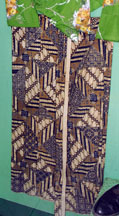 |
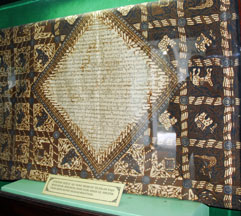 |
| Palace guard (left) and royal batik sarongs at the Yogyakarta Palace. | |||
Batik in Java and Bali, Indonesia
| Batik is done around the world and has evolved to a very high level in Java and Bali. First done by court ladies for palace attire, it is now widely produced and available to all. While certain motifs were at one time reserved for royalty, today these forbidden motifs are available to the public. |
 |
 |
 |
 |
| Palace guard (left) and royal batik sarongs at the Yogyakarta Palace. | |||
|
Batik is a wax resist process. Bees wax and tree resin are
the main ingredients of the wax recipe, but as many as five other components are
combined to produce three types of wax
recipes that are utilized for drawing the principle lines and for filling them
in, for covering large areas that will remain white, and for covering blue-dyed
areas.
The most common ways to apply wax to cloth is by stamping with copper caps (pronounced chops) or by drawing with canting (pronounced chanting) tools. Combination fabrics are produced with both caps (for the outlines) and canting (to add details) techniques. The fabric retains its original color wherever the wax has been applied. The waxed cloth is dyed, then more wax is applied to preserve the dyed color. The process is often repeated - waxing, then dying - several times, then the wax is removed, producing a colorful, patterned fabric. Traditionally, only soga brown and indigo blue dyes were used, but today a rainbow of colors are popular. |
|
These pictures were taken at
Galeri Batik Kuno Danar Hadi, at Jl. Slamet Riyadi 261 Solo
(Surakarta), Java, Indonesia, telephone (0271) 714326.
Pictures were not allowed in the fabulous museum or showroom, but many of the pieces are included in the excellent book published in Batik: The Impact of Time and Environment, by H. Santosa Doellah. The factory is located behind museum. Below, you can see how copper caps (dipped in hot wax) are used to stamp repeat designs onto cloth: |
|||
 |
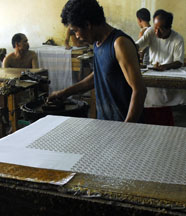 |
 |
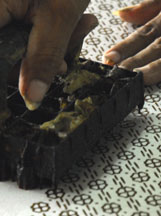 |
| Clean, smooth white cloth is laid onto a padded, water proof table. | The cap is dipped into hot wax.... | ...then carefully lined up, and pressed firmly onto the cloth. | Wires in the outer corners of the cap are placed on flower centers for correct registration. |
| Applying wax with canting tools (the tulis technique) is more labor intensive: | |||
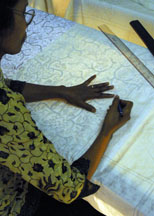 |
 |
 |
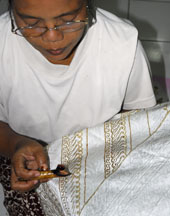 |
| An image is traced onto cotton or silk fabric with a pencil. | Canting tools come in a variety of sizes. They are dipped into hot wax from a centrally located heated pot to fill the receptacle... | ...then the fine spout (which can easily clog) is usually blown clean. | The pencil lines are covered with wax, often on both sides of the cloth. |
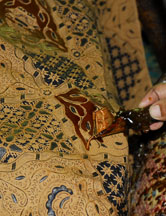 |
 |
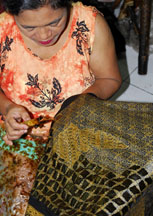 |
 |
| After the cloth has been dyed, more wax is applied for another color. Wax is sometimes removed after dying before reapplying wax for the next color. | |||
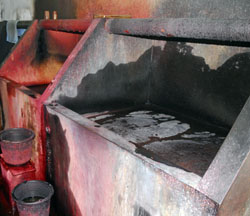 |
 |
 |
| After the waxed cloth has been inspected for errors, it is immersed into cold water dye. | The dyed cloth is then air dried. While blue and brown are traditional, today a number of colors are utilized. | |
 |
 |
 |
| Dye may be hand painted onto the waxed cloth. This is done with only small areas of color are desired. | The wax is removed in hot water. | |
| These pictures where taken at Batik Plentong, Jl. Tirtodipuran 48, Yogyakarta, Java, Indonesia, telephone (0274) 373777. | |||
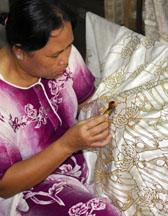 |
 |
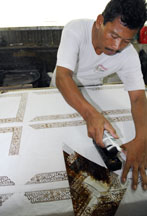 |
 |
| Wax is applied with a canting tool. | A triangular piece of heavy plastic is place over the corner (and under the waxed cap) in order to create mitered corners. | ||
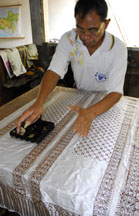 |
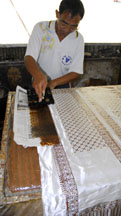 |
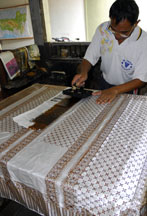 |
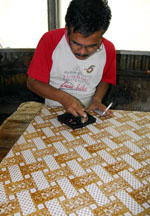 |
| Three different caps were used to apply wax on this light-weight cloth. Each was carefully lined up to produce a seamless pattern. The wax penetrated well, so it was stamped on only one surface. | Wax must be applied to both sides of heavier cloth. | ||
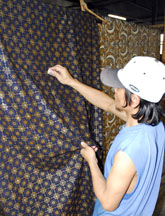 |
 |
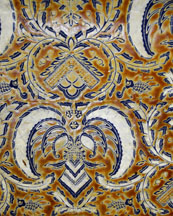 |
| Wax is scraped off areas that will be dyed a different color. | ||
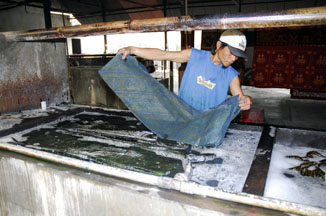 |
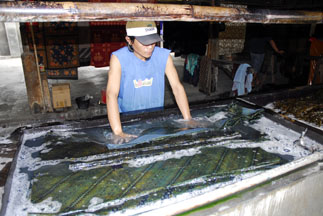 |
| The cloth is submerged in dye in a high, rectangular, shallow vat like this one. | |
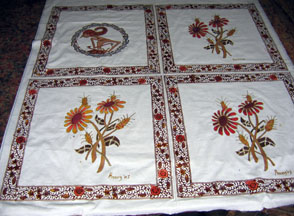 |
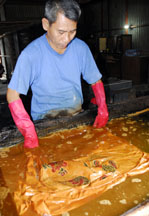 |
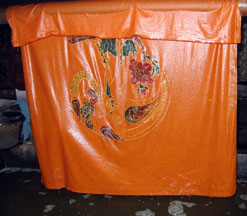 |
| Small areas are hand painted with dye before being dipped into another dye. | ||
 |
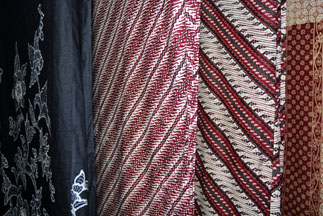 |
| Wax is removed from the cloth in hot water, then the cloth is hung to dry. | |
| The following pictures where taken at Batik Indah Raradjonggrang, Jl. Tirtodipuran 6A (18), Yogyakarta, Java, Indonesia, Telephone: (0274) 375209, Fax: (0274) 378653. | |
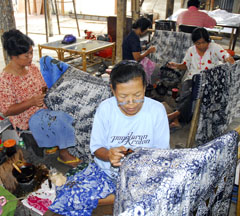 |
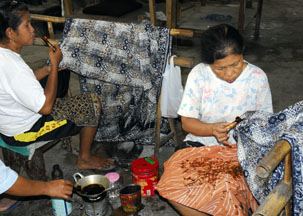 |
| Wax is applied with canting tools. The tip is often blown clear of wax. | |
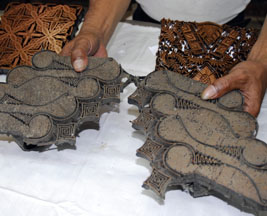 |
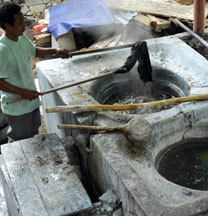 |
 |
| Pair of caps for stamping front and back of cloth with wax. | The wax is removed from the cloth in hot water, then it is hung to dry. | |
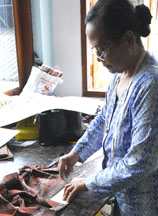 |
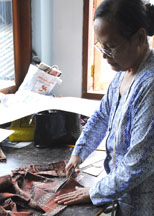 |
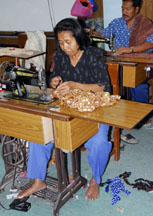 |
| Cloth is marked, cut, and sewn to transform it into clothing that is sold in their store. | ||
| The following pictures where taken at Batik Rakyat, a non-profit foundation in Imojiri, Yogyakarta, Java, Indonesia, Telephone: (0298) 596333. | |||
 |
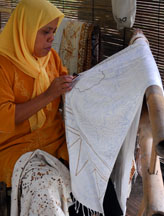 |
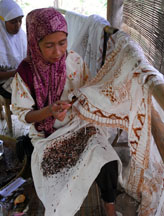 |
 |
| The design is traced onto the cloth on a glass-topped, slanted table. | A canting tool is used to cover the lines with wax, then canting tools of various diameters are used to fill the outlines with patterns. | ||
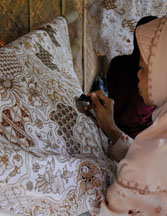 |
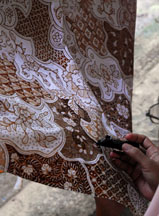 |
 |
| Several types of wax are used on each cloth. | Waxed, dyed, and finished cloths in the storage and sales area. | |
| Wiji designs and sells colorful figurative and abstract batik paintings at his studio/showroom, The Batik Painting Gallery of Wiji Hartono / Kabul, at Jl. Timoho No. 29A Yogyakarta, Java, Indonesia, Telephone: (0274) 566669, 516069, Fax: 062-274-566669, kabul_gallery@yahoo.com | ||
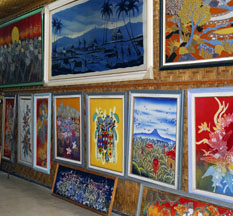 |
 |
 |
 |
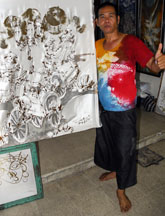 |
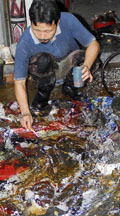 |
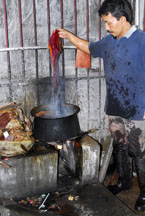 |
| The image is drawn onto fabric with a pencil, then assistants cover the lines with hot wax. The waxed cloth is dipped into dye and then... | ...other colors are painted directly onto the wet cloth on the floor. | The wax is removed in boiling water, then the cloth is dried and framed. | |
Contemporary designs are also produced for tourists and export in Bali:
| At Bali Bidadari Batik, Denpasar, Bali, Indonesia, Telephone: (0361) 462832 . . . | |
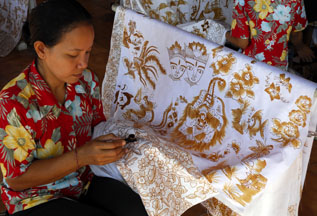 |
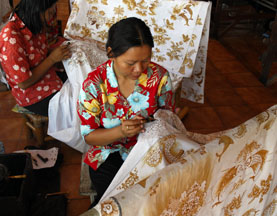 |
| . . . wax is applied to the cloth with canting tools, then the cloth is processed. | |
| At the Batik Centre, Kembang Bali, Jl. Penestanan Kaja, Ubud, Bali, Indonesia, Telephone: (0361) 974447 . . . | ||
 |
 |
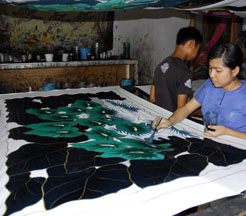 |
| . . . a pattern is traced onto rayon or cotton, the fabric is stretched onto a frame, the lines are canted with wax, the image is hand painted with dye and cotton swabs, then the wax is removed. | ||
Highly Recommended Non-Governmental Organization:
Threads of Life
Recommended Guides:
Competent bilingual guides (with their own vehicles) are essential.
Mr. Ignatius (Telephone 0816 683 202) was my excellent guide in Java.
Rudy (arranged through Tutut) was my fabulous guide in
Bali.
Recommended Books:
Batik: The Impact of Time and Environment, by H. Santosa Doella, published by Danar Hadi,
Surakarta, Java, Indonesia, 2002, ISBN 979-97173-1-0.
Batik: Design, Style, and History, by Fiona Kerlogue, published by Thames
& Hudson, London, 2004, ISBN 0-500-28477-6.